October 7th 2020
Welcome to the second edition of xFO!
Always bringing the latest in football and data analytics. This weeks edition is about analyzing five signings, made by different Premier League teams, through relatively unknown and underused statistics to analyze individual player performance.
One of the most exciting, hopeful, anxious and possibly disappointing parts to any season is the summer transfer window. Fans are glued to their phones, laptops and TVs for the latest news on which players their teams are going to buy for the upcoming season. Excitement and hopefulness set in when a team is linked to a superstar player or one who will drastically improve a team’s performance from the previous season. The anxiousness begins once reports of negotiations between clubs begin, and last until the player is at their new club signing their contract. Not every transfer window is a successful one and fans are, at times, left disappointed and fearing the worst because there hasn’t been the spending or ambition to sign players to improve results on the pitch.
When a team brings in multiple players during a transfer window, one signing tends to catch the eye more than the others. The media calls these standout transfers as marquee signings. This summer we have seen a variety of marquee signings in the EPL. Whether these signings have been by an underachieving team such as Everton signing a world-class player like James Rodriguez, or hopeful title contenders like Chelsea and Tottenham signing Timo Werner and Gareth Bale respectively. The expectation is that these marquee signings have almost an instantaneous impact. This article will focus on the 5 marquee signings that were completed before the October 5th deadline and see, statistically, which signing will have the most positive impact.
Continuing the theme from the last article about underused and relatively unknown statistics within football, there are statistics geared towards evaluating individual players which can sometimes be used to analyse and indicate how the players will impact their team in the upcoming season. The player graphics in this article are all from understat.com, a great free source for getting xG and other stats of teams, players, and specific matches. These graphics only take into consideration the games played in the respective leagues.
James Rodriguez:
The first marquee signing to be discussed is James Rodriguez. Many pundits and football analysts have called this ‘the signing of the season’ and they have a very good argument for this opinion. The fact that Everton, who finished 12th last season, were able to sign a former World Cup Golden Boot winner who played for Real Madrid and Bayern Munich to join their squad is quite miraculous. Ancelotti surely played a deciding factor for James to join Everton thanks to their history together, but it is still a major boost in Everton's ambition. Below is James’ player graphic for last season.
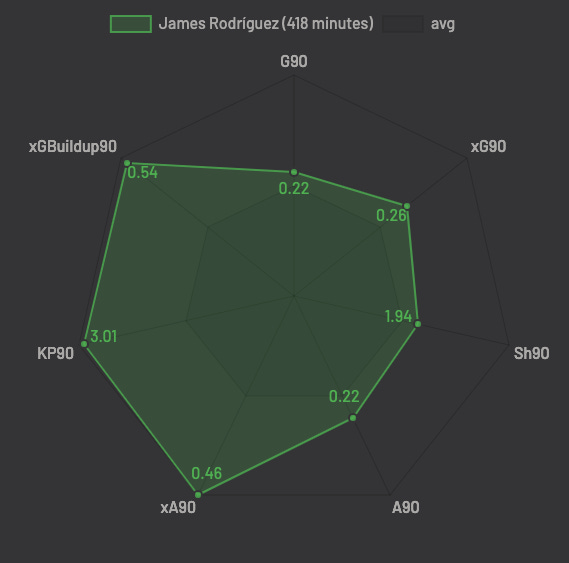
The statistic that instantly jumps out is the KP90 which stands for key passes per 90 minutes. KP90 quantifies how many shots are created from the player's pass per 90 minutes. According to the graphic, James creates an average of 3.01 shots per 90 minutes for his team. This would rank second in the EPL last year behind De Bruyne and ahead of Alexander-Arnold. One might think this statistic is heightened by the low amount of minutes James played last season. His KP90 since the 2014/2015 season is 3.39, and in his most recent prolific season at Bayern Munich in 2017/2018 where he registered 11 assists in the Bundesliga, his KP90 was 3.52. So, despite playing less than 500 minutes last year, he was able to have the same impact on his team’s goal opportunities than when playing over a thousand minutes. What this stat indicates is James’ ability to find teammates in good goal scoring positions. As an old school number 10 player, he plays to receive the ball in between the opponent’s midfield and defensive line and then plays through-balls to forwards and wingers making runs-ins behind the defenders.

Credit: Everton YouTube
Similarly, with his accurate passing, he is able to switch the play to teammates from 40-45 meters and catch the defence out of position, and create goal scoring opportunities. The impact this will have on Everton is creating more goal-scoring opportunities in general, but more importantly, more opportunities from the middle of the field. As seen below, four out of Everton’s top five players in terms of KP90 are all wide players.

This model made Everton one-dimensional in that most of their chances came from wide areas. With James, opposing teams can get beat centrally and from the wings, and this will increase the quantity and quality of the goal-scoring chances for Richarlson and Calvert-Lewin. The latter is already reaping the rewards with this setup. Similarly, after the first three-game weeks, James is the only player who has created more than 10 goal scoring opportunities which average just over three per game.
Thiago Alcantara:
In my previous article, I mentioned that signing Thiago would be the factor to look out for to keep Liverpool within the top two teams in the EPL. He is a world-class player who will add depth and talent to their industrious midfield. A player known for his superb technical ability, he is most suited to dictate the play from deep and start attacks.
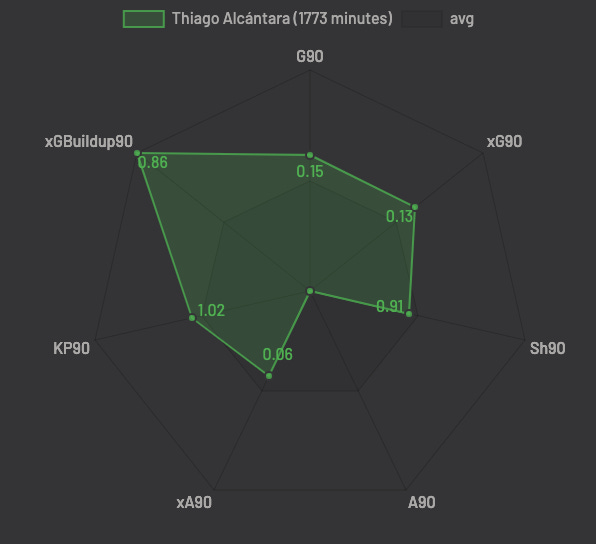
As seen by his player graphic, there is one stat that overshadows the rest, xGBuildup90. The xGBuildup90 statistic has a variety of names and is calculated differently by different statistics and data collecting companies. Despite these differences, the stat indicates the same which is the total xG of every possession the player is involved in, excluding their key passes and shots per 90 minutes. In other words, this stat measures the total xG of the player’s team where the player themself did not create the assist for the shot or take the shot itself. At first thought, this may seem like a useless stat. However, having a high xGBuildup90 can indicate a player who starts good quality attacks frequently and finds his teammates in between the lines consistently where the teammate can create even better quality opportunities.
In ice hockey, any goal can have up to two assists. One is awarded to the player who made the pass directly leading to the goal, while the other assist is awarded to the player who passed the puck to the player who made the direct assist. This is what the xGBuildup90 tries to measure. In Thiago’s case, there is an 86% chance that when a shot is taken or a goal is scored by his team, he was involved in the play, but not making the assist or taking the shot. This makes sense as he has mostly been deployed as the deepest midfielder, and explains the zero assists he had last season. His role is not to create assists, but rather find his teammates further up the pitch in dangerous positions for them to create the goal-scoring opportunities. There are two types of defensive midfielders. Those like Kanté and Fabinho who protect the back four players, and other defensive midfielders like Thiago, Kroos, and Jorginho who dictate the team’s play from deep and use their technical ability and knowledge of the game to be at the right place at the right time to receive the ball and transition defense and/or a loose ball into offense quickly. This will help Liverpool tremendously as their usual outlets to start attacks are Robertson and Alexander-Arnold. Opposing teams have shown that if they are able to limit both fullbacks, Liverpool’s attack becomes easier to defend. Adding Thiago gives Liverpool a unique technical player for opposing teams to worry about. They will no longer focus on defending the wide areas because this will leave Thiago picking out one of the front three players in central areas.
With teams starting to play a low defensive block against Liverpool to limit the space behind their defenders, it is crucial to have players who are able to constantly be involved in possession, and who consistently find the pass that breaks down the defense as they are shifting from side to side. This is what Thiago will add to Liverpool. He will consistently recycle possession and find players in between the lines or blind spots of defenders and midfielders to break the defensive blocks and build great quality opportunities and claim the hockey assist for scoring opportunities.
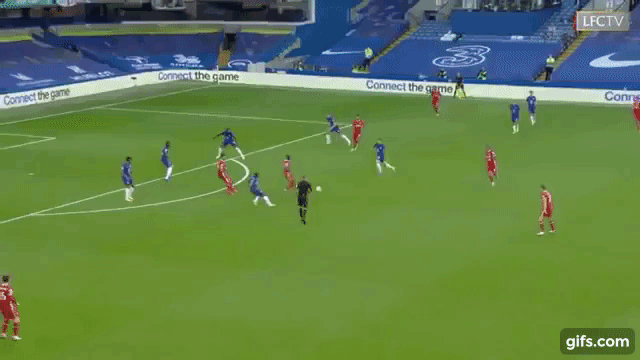
Credit: Liverpool Youtube Channel
Timo Werner:
xG is a very powerful and flexible statistic. It can be used to predict results and/or indicate how well a team played. It can also be used for individual players and how they performed after a match or throughout a season. xG used for teams and individual players is calculated the exact same way. However, when measuring the total xG of an individual player, only the shots that specific player takes are added up. For incoming strikers, teams use xG and xG90 (expected goals per 90 minutes) to measure the quality, quantity of shots and finishing ability of the player. Comparing total xG with the number of actual goals the player has scored gives a hint on how clinical a striker can be.
Chelsea has spent the most money in Europe so far in this transfer window, but have gotten some very good players such as Timo Werner and Hackim Ziyech formerly of RB Leipzig and Ajax respectively. Most consider Werner as Chelsea’s marquee signing due to his relatively young age, his goal scoring ability and the talent he has shown the past two seasons.
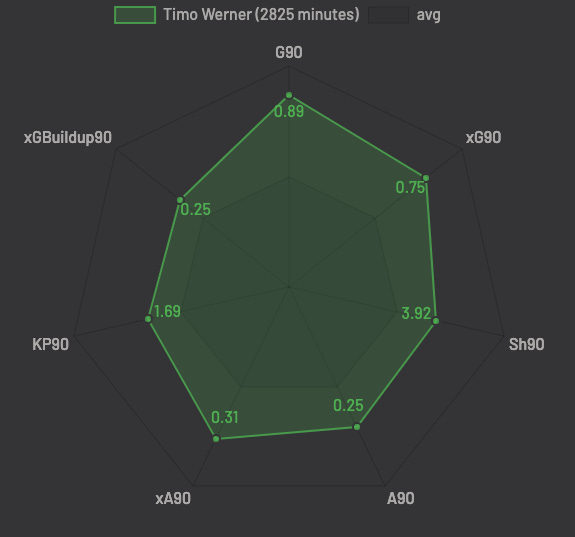
If we took Werner’s xG90 from last season and compared it to last year's EPL players statistics, Werner would come second. Although the Bundesliga is shorter because there are fewer teams than in the EPL, Werner is in the same range of minutes as most EPL players. The reason why it is best to use xG90 is that it separates the great players from the good players. Great players are able to consistently find and take high-quality shots while good players do not. Using actual goals per 90 (G90) allows for other factors to come into play, which may distract from focusing on the player’s actual skill to create or identify space to shoot a high goal scoring opportunity.
Similarly, Chelsea and RB Leipzig, Werner’s former team, are at the same level with both teams expected to score 76 goals last season. The major difference is that Leipzig outperformed their xG while Chelsea underperformed theirs. Werner is the main reason for this difference regarding the performance of the two teams. This can be seen in his player graphic where he himself outperformed his xG90 by finishing more opportunities that had a low xG. The gif below shows him converting an opportunity, against Union Berlin, that was given an xG of .05 by understat.com and shows his great finishing ability.
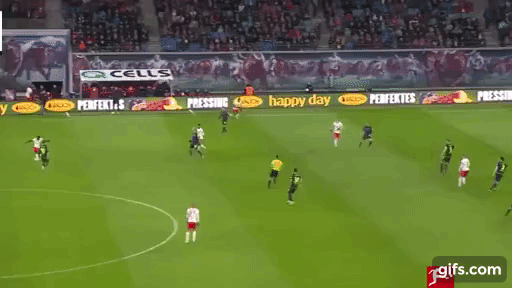
Credit: Bundesliga Youtube Channel
He finished last season with a higher xG90 than any Chelsea player. Therefore, we can conclude that Chelsea’s finishing should improve thanks to a more clinical striker. Chelsea fans will be hoping the chances missed last year are capitalized this year to increase their point tally from last season.
Gareth Bale:
Gareth Bale ended his seven-year stint in Madrid to rejoin Tottenham on a one year loan. Bale’s talent is unquestionable and he has proven to be a difference maker on the biggest stage. However, his injury record is not favourable and he has only completed around 2000 minutes of league play once since the 2014/2015 season. This limits his impact on the team. His player graphic seen below shows the limited impact and relative average stats he has achieved due to injuries and limited playing time when fit.
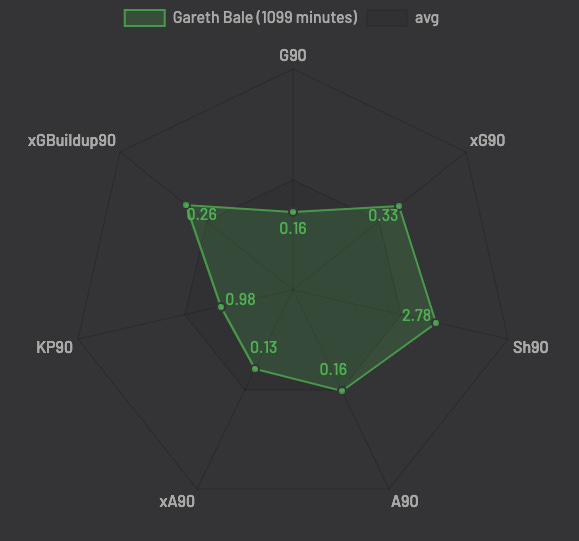
What makes Bale’s transfer so interesting is that despite not having had his best season, this player has still outperformed most attacking players in the Tottenham squad. A comparison between his stats and the player he will most likely replace, Lucas Moura, can be found below.
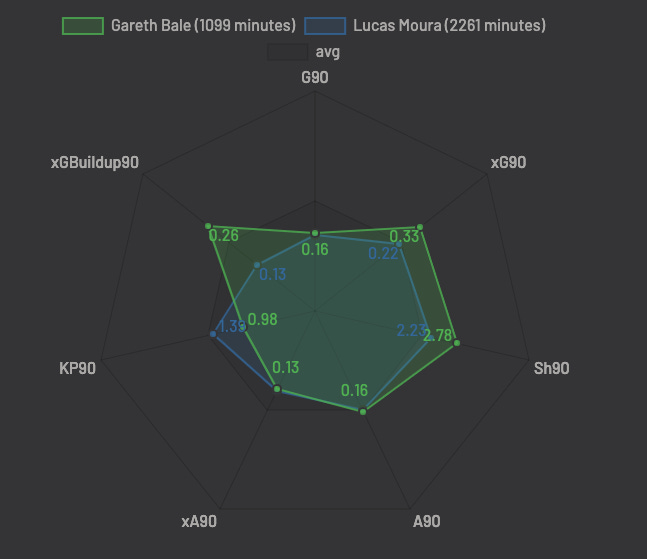
There are few teams that would pass on the opportunity to sign a player like Bale, so for Spurs, it was an easy decision to sign him and improve the team, increase the depth of the squad and create excitement for the fans after a very poor season last year. There is more to football than just stats and data analytics that help the sustainability of the club on and off the pitch. Keeping fans happy will create better atmospheres on matchdays, create more revenue on merchandise and during matchdays, and keep the players hungry to fight for their starting position and for competing in all competitions.
On the field Bale, through his pace, shooting and underrated passing ability, is accustomed to having a direct impact on matches. However, recently he has not been able to show this. His player profile indicates an eagerness to directly impact the game by taking low-quality shots in an attempt to score goals and warrant more playing time from Zidane. This is shown through his Sh90 (shots per 90 minutes) being quite high, 2.78 in comparison to his xG90 being relatively low at 0.33. This is lower in comparison to Tottenham’s two top goal scorers last year, Harry Kane and Son Heung-Min. To put this into context, a player with a .50 xG90 means they are scoring once every other game. What I believe Spurs are hoping for is that Bale’s switch back to London, playing under a team and manager that support him, will alleviate the pressure to make an impact every time he gets the ball just to get more game time. With better decision making and playing consistently, he will settle in and create chances for himself and the team. However, this will only happen if he is able to stay fit and not injure, something that he has severely struggled with throughout his career.
Willan:
The last marquee signing that will be discussed in this article is the most shrewd deal. A free transfer from Chelsea to Arsenal, Willian will be an incredibly important player this year for the Gunners. A veteran with many years of EPL experience, he has proven to be a player that offers a bit of everything.
Usually deployed as a winger, Willian can cut inside from both sides of the pitch and shoot to the far corner or cross the ball to a teammate. His player graphic supports this, Last year he achieved over two and a half key passes per 90 minutes and just under two and a half shots per 90.
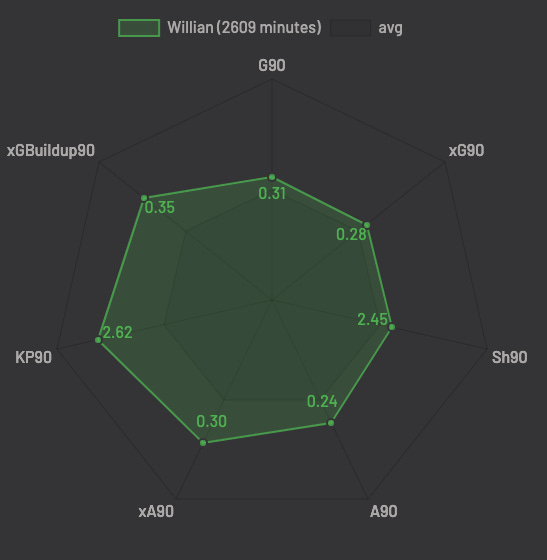
Unlike some of the previous marquee signings, Willian is not considered a superstar player, but is consistent and plays at the same level every single game. This is exactly what Arsenal need at this time. With many young and promising players, Willian is acting as a stop gap for the young players to reach their potential while helping Arsenal remain competitive in all competitions they are in. Taking a look at Arsenal’s squad statistics from last year, it can be seen there were no players as versatile as Willian. Aubameyang and Lacazette were the goal scoring threats, while Pepe and Ceballos were the creative players. Even this being the case, Willian has better stats than both Pepe and Ceballos in all categories. This is presented in the player graphic comparison below. His creativeness was on full show in the first game of the season, where he assisted 3 times in Arsenal’s 3-0 vs Fulham.
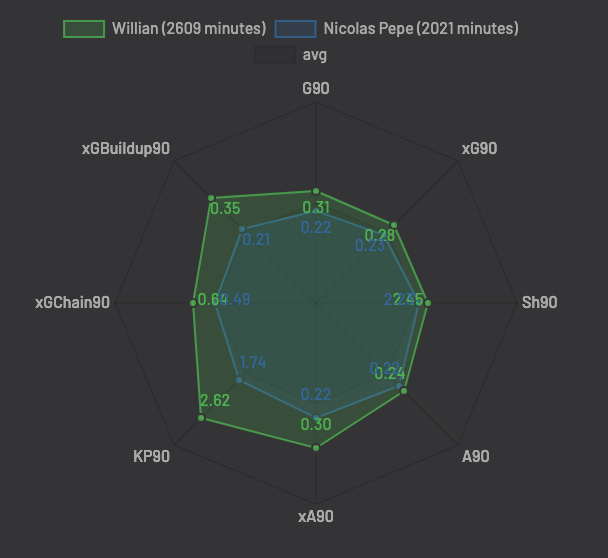
Overall, Willian will be an important player for Arsenal in these next few years. His ability to score and assist from both sides of the pitch will trouble teams and be helpful for Arsenal where rotation will be a prevalent characteristic for all teams in this fully packed season. Willian will not be the leader in goals or assists, but he will be crucial to all the success Arsenal will have this season. You can watch highlights of his Arsenal debut here, where he shows the versatility in his game. He is definitely a player to watch this season.
Conclusion:
The marquee signing that will have the biggest impact, in my opinion, is James. He is a special talent that has joined a team that has been underachieving for years now. He has been an extremely influential player in the teams he has played for, and the signs at Everton in his first four games are promising. Most of Everton’s exciting plays and high-quality chances involve James in some way. The statistics show James is considerably better than the players Everton had. This is the perfect combination of an underachieving team and a player who has a point to prove. This combination becomes a major factor and is the main reason James will have the biggest impact. Everton will finish above their 12th place finish from last year.
It is important to keep in mind that statistics and data should not solely be used to make decisions in recruitment, tactical decisions and predictions. With the transfers of Bale and Willian we have seen that teams take into account many other factors. Stats and data say one thing, but it is equally important to scout if what the player does on the field supports and confirms what the statistics indicate. For example, within player recruitment, statistical analysis is mostly used as a filter to create a list of potential players that can fulfill a certain role. As mentioned in the book ‘Soccermatics’ by David Sumpter, Leicester’s scouting team, which included Steve Walsh used a spreadsheet and sorted it by the stat they were most interested in. In this case, it was tackles per game, and at the top of the list was N’golo Kanté who was playing for French side Caen. Walsh later used the same strategy as director of football for Everton where he signed player number 2 on that list, Idrissa Gueye, who now plays for PSG. For both players, stats were used to filter or identify the player with the trait the team wanted, and then scouts were sent off to confirm whether or not the player and what he did on the pitch supported the stats. Both signings were successful in their own ways.
Stats are a great indicator and predictor of what a player can offer, but similarly to xG, the stats mentioned in this article are influenced by a variety of factors that can positively or negatively influence whether a player will over or under achieve the stats from the season before. The importance here is to understand that statistics and data analysis can aid in decision making on and off the pitch, but it should not be the sole deciding factor.


